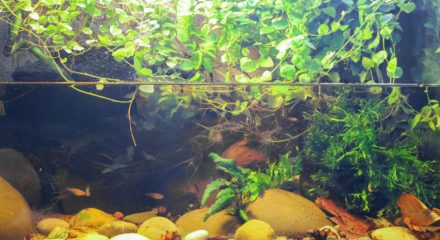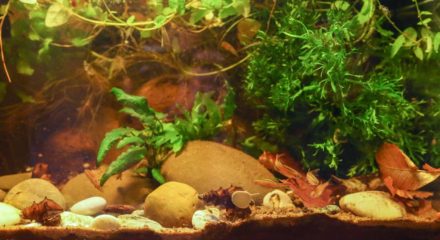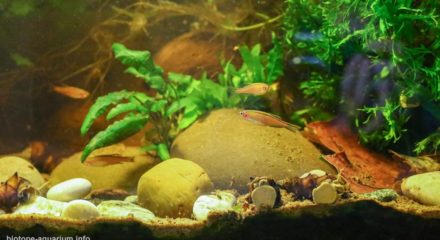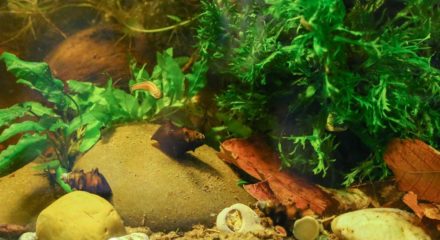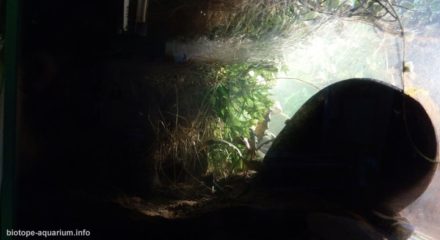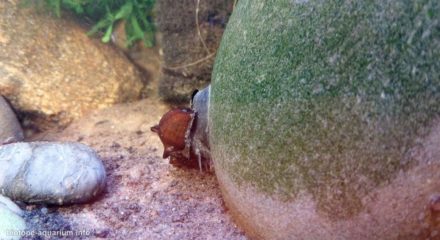Moei River tributary backwater, Irrawaddy basin, Burma
31st place in Biotope Aquarium Design Contest 2016
![]() Russia. Natalia Sokolova
Russia. Natalia Sokolova
Aquarium Volume: 60 L
Fish and invertebrates: Brotia pagodula, Danio choprai
Plants list: Microsorum pteropus, Ceratopteris thalictroides, Cryptocoryne albida, Cryptocoryne wendtii
Biotope description: It is a biotope of snails Brotiapagodula, endemic to the area. Although the first description of these snails appeared in 1847, they are still rare guests in our aquaria, and nobody has not yet managed to achieve a stable breeding in captivity. These mollusks are amazingly beautiful and gentle creatures. They eat in nature, apparently, a special genus of algae and plancton. In the aquarium they find food among the rocks, as well as capture fine particles of soluble tablets for fish. To recreate their natural environment in the aquarium I had to install two fairly powerful pumps that create movement of water. As snails are very sensitive to the purity and freshness of water, so we had to arrange daily change. This viviparous mollusks, presumably breed every year. In my aquarium one female gave birth at the same time to 8 small snails. They grow quite slowly, gradually emerging spikes, but unfortunately I was not able to maintain and grow young ones. Together with them there are Danio choprai, a small schooling fish. In nature, in this body of water, we could find just Schisturas or Balitoras. In the aquarium to keep these species together with snails is dangerous because of the eating habits of loaches. Unfortunately, the political situation in this area is not stable, and there is no opportunity to explore these amazing water with undiscovered species (recently described a new species Danio absconditus, Psilorhynchus olliei, Schistura shuensis and others). Vegetation in the backwater is pretty sparse, often the roots of the plants growing on the banks (for example, Ficus pumila). Between the rocks you can find Thai fern, hornlike fern and various crypts.
Fish and invertebrates: Brotia pagodula, Danio choprai
Plants list: Microsorum pteropus, Ceratopteris thalictroides, Cryptocoryne albida, Cryptocoryne wendtii
Biotope description: It is a biotope of snails Brotiapagodula, endemic to the area. Although the first description of these snails appeared in 1847, they are still rare guests in our aquaria, and nobody has not yet managed to achieve a stable breeding in captivity. These mollusks are amazingly beautiful and gentle creatures. They eat in nature, apparently, a special genus of algae and plancton. In the aquarium they find food among the rocks, as well as capture fine particles of soluble tablets for fish. To recreate their natural environment in the aquarium I had to install two fairly powerful pumps that create movement of water. As snails are very sensitive to the purity and freshness of water, so we had to arrange daily change. This viviparous mollusks, presumably breed every year. In my aquarium one female gave birth at the same time to 8 small snails. They grow quite slowly, gradually emerging spikes, but unfortunately I was not able to maintain and grow young ones. Together with them there are Danio choprai, a small schooling fish. In nature, in this body of water, we could find just Schisturas or Balitoras. In the aquarium to keep these species together with snails is dangerous because of the eating habits of loaches. Unfortunately, the political situation in this area is not stable, and there is no opportunity to explore these amazing water with undiscovered species (recently described a new species Danio absconditus, Psilorhynchus olliei, Schistura shuensis and others). Vegetation in the backwater is pretty sparse, often the roots of the plants growing on the banks (for example, Ficus pumila). Between the rocks you can find Thai fern, hornlike fern and various crypts.

